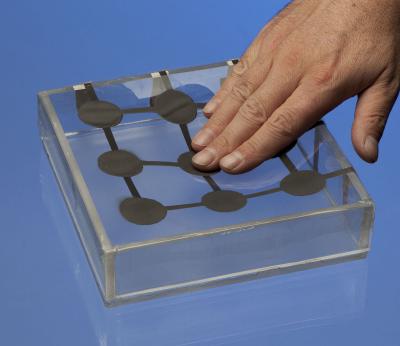Debuting at the Sensor+Test trade fair in Nuremberg from June 7-9, 2011, researchers have now developed sensors capable of expanding, in extreme cases, to twice their original length - and they are so supple they are virtually unnoticed when sewn into clothing.
"The sensor films can measure stretch, as well as pressure," says Dr. Holger Böse, Scientific and Technical Manager of the ISC's Center Smart Materials. "They are made of a highly stretchable elastomeric film, coated on both sides with flexible electrodes. Whenever the sensor is stretched by changes in the shape of the seat, the sensor's thickness and, as a result, its electrical capacitance also change, which we can measure."
In contrast to conventional, rather inelastic strain gauge strips, the new dielectric elastomeric sensors can stretch by up to 100 percent in extreme cases – in other words, they can be drawn out to twice their size.
Dielectric elastomer sensors can be customized and applied in a variety of ways. Credit: Fraunhofer ISC
Depending on the field in which the smart materials are applied, it might be necessary to coat the elastomer film with multiple electrode pairs. This is the case, for example, when measuring the distribution of body pressure to determine a person's posture in a seat. Each pair of electrodes serves, in effect, as an independent sensor, measuring the local strain.
"This is how we can say precisely where and to what degree the pressure has changed," explains Böse.
In making the sensors, the researchers choose the material that best meets the specific requirements of each application. The elastomer film consists of a polymer in which the individual molecules are chemically bonded with one another. The better the network of molecules, the sturdier the material – similar to how a fine-mesh fishing net is stronger than one with a larger mesh. The degree of bonding in the polymer can be controlled by the scientists.
"If the sensor is being used to measure high pressures, we produce a sturdier elastomer film as substrate; for measuring lower pressures, we use more pliant films," says Böse.
These sensors have other applications. For instance, they can be used to measure the pressure of gases. To do this, the elastomer film is stretched like a membrane across a ring. If gas exerts pressure on the sensor membrane, it deforms – which is detected by the sensor. Pressure sensors are also useful in safety technology: If someone enters an area too close to a hazardous machine, sensors embedded in the floor can detect this and set off a warning. These intelligent materials could even be integrated into clothing: Here, they might be used to analyze sequences of movement, thereby helping athletes to optimize their training. Because they are so flexible, sensors that are part of clothing are hardly noticeable at all.






Comments